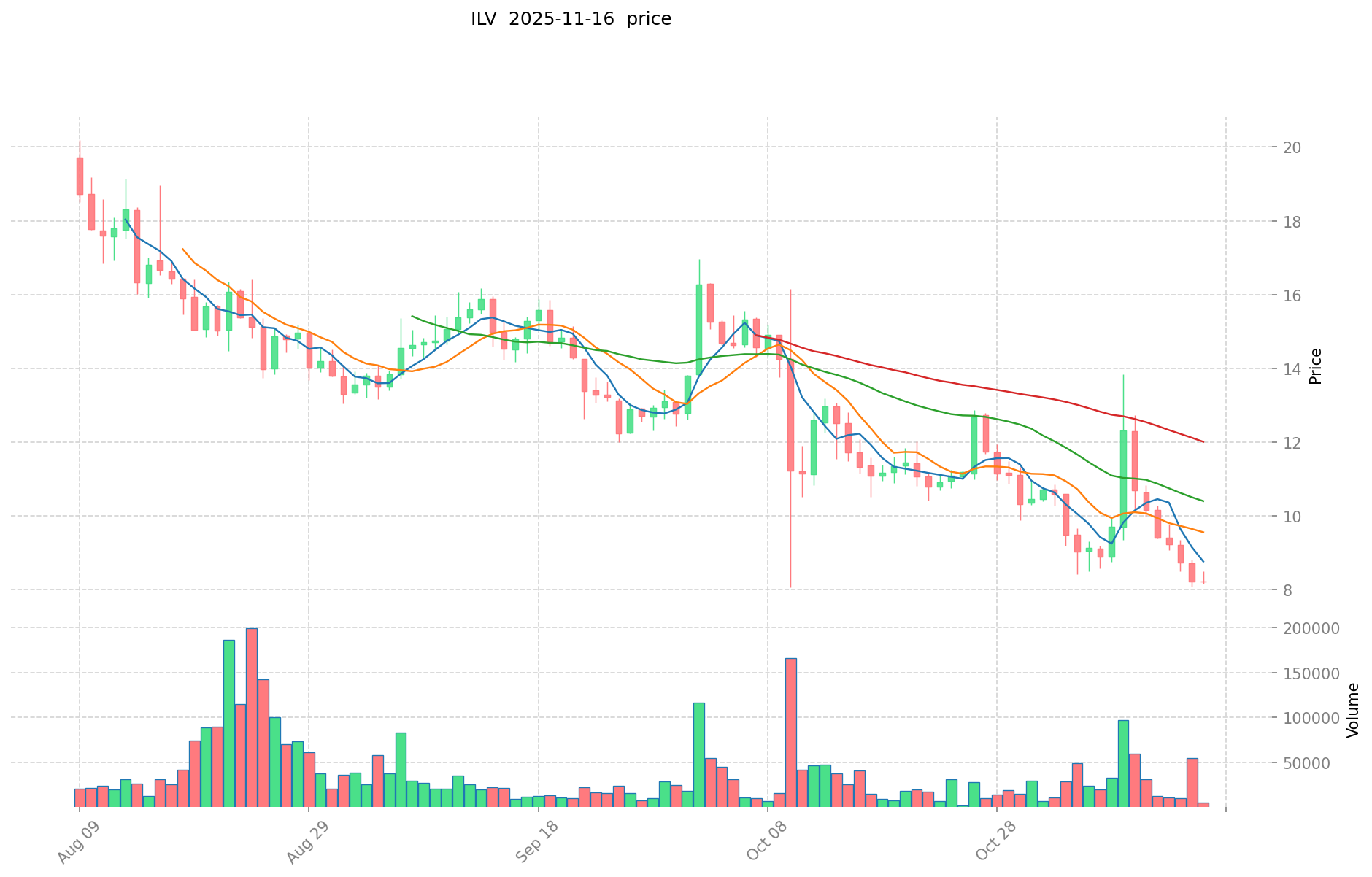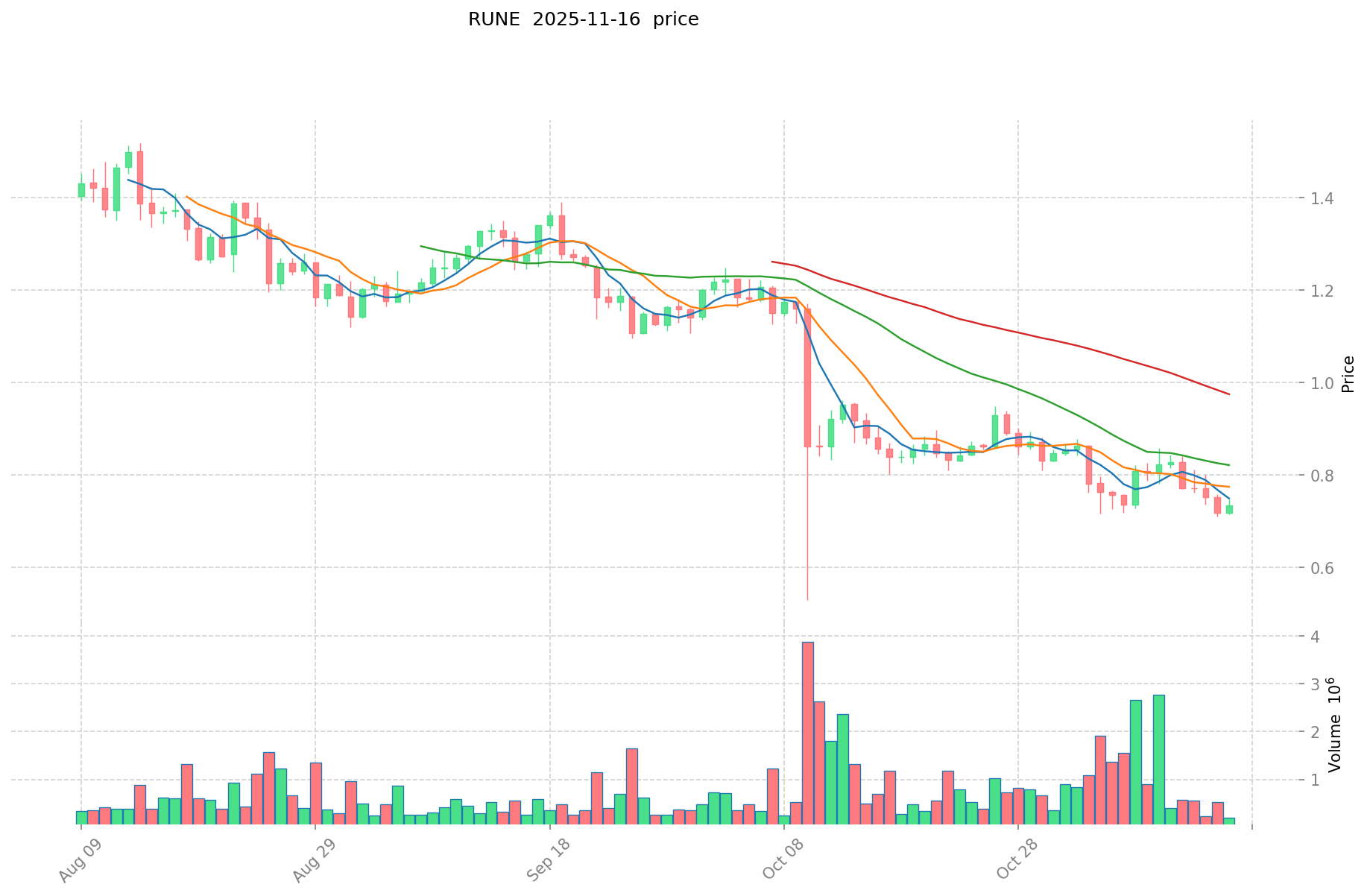ILV vs RUNE: Comparing Two Leading Blockchain Gaming Tokens
Introduction: ILV vs RUNE Investment Comparison
In the cryptocurrency market, the comparison between Illuvium (ILV) vs THORChain (RUNE) has always been an unavoidable topic for investors. The two not only show significant differences in market cap ranking, application scenarios, and price performance, but also represent different cryptocurrency asset positions.
Illuvium (ILV): Since its launch in 2021, it has gained market recognition for its position as an open-world GameFi game based on the Ethereum network.
THORChain (RUNE): Introduced in 2019, it has been hailed as a highly optimized multi-chain platform, representing one of the cryptocurrencies with significant global trading volume and market capitalization.
This article will comprehensively analyze the investment value comparison between ILV and RUNE, focusing on historical price trends, supply mechanisms, institutional adoption, technological ecosystems, and future predictions, attempting to answer the question most concerning investors:
"Which is the better buy right now?"
I. Price History Comparison and Current Market Status
ILV and RUNE Historical Price Trends
- 2021: ILV reached its all-time high of $1911.26 on November 30, 2021.
- 2021: RUNE hit its peak price of $20.87 on May 19, 2021.
- Comparative analysis: In the current market cycle, ILV has dropped from its all-time high of $1911.26 to its current price of $7.694, while RUNE has fallen from $20.87 to $0.7057.
Current Market Situation (2025-11-17)
- ILV current price: $7.694
- RUNE current price: $0.7057
- 24-hour trading volume: ILV $182,071.05 vs RUNE $271,173.41
- Market Sentiment Index (Fear & Greed Index): 10 (Extreme Fear)
Click to view real-time prices:
- Check ILV current price Market Price
- Check RUNE current price Market Price


II. Core Factors Influencing the Investment Value of ILV vs RUNE
Supply Mechanisms Comparison (Tokenomics)
- ILV: Fixed supply of 10 million tokens with a deflationary model where tokens are burned during gameplay in the Illuvium ecosystem.
- RUNE: Emission-based model with an initial supply of 500 million tokens and continuous liquidity provision incentives through THORChain's network.
- 📌 Historical Pattern: Deflationary tokens like ILV tend to experience price appreciation during bull markets, while RUNE's value is more directly tied to the TVL and trading volume on THORChain's network.
Institutional Adoption and Market Applications
- Institutional Holdings: RUNE has gained more institutional interest due to its cross-chain liquidity solution that appeals to trading firms and DeFi investors.
- Enterprise Adoption: THORChain (RUNE) offers permissionless cross-chain swaps utilized by various DeFi platforms, while Illuvium (ILV) remains primarily focused on gaming applications.
- Regulatory Stance: Both tokens face regulatory uncertainty, but THORChain's decentralized structure may provide some regulatory advantages compared to Illuvium's more centralized gaming ecosystem.
Technical Development and Ecosystem Building
- ILV Technical Upgrades: Expanding their AAA-quality gaming ecosystem with multiple interconnected games and land-based NFT economy.
- RUNE Technical Development: Continuing to add support for more blockchains to their cross-chain liquidity protocol and improving security after previous exploits.
- Ecosystem Comparison: RUNE has a more established DeFi ecosystem with real utility in cross-chain swaps, while ILV is building a comprehensive gaming metaverse with multiple revenue streams and NFT integration.
Macroeconomic Factors and Market Cycles
- Performance in Inflationary Environment: RUNE potentially offers better inflation protection through its utility in facilitating cross-chain liquidity.
- Macroeconomic Monetary Policy: Both tokens are affected by broader crypto market sentiment driven by Federal Reserve policies, but gaming tokens like ILV may be more volatile during rate hikes.
- Geopolitical Factors: RUNE's cross-chain capabilities make it potentially more valuable in regions with restrictive crypto policies due to its permissionless nature.
III. 2025-2030 Price Prediction: ILV vs RUNE
Short-term Prediction (2025)
- ILV: Conservative $4.47 - $7.70 | Optimistic $7.70 - $11.17
- RUNE: Conservative $0.47 - $0.70 | Optimistic $0.70 - $1.03
Mid-term Prediction (2027)
- ILV may enter a growth phase, with an estimated price range of $8.82 - $14.12
- RUNE may enter a growth phase, with an estimated price range of $0.91 - $1.25
- Key drivers: Institutional capital inflow, ETF, ecosystem development
Long-term Prediction (2030)
- ILV: Base scenario $8.42 - $16.20 | Optimistic scenario $16.20 - $18.14
- RUNE: Base scenario $1.29 - $1.46 | Optimistic scenario $1.46 - $2.13
Disclaimer: This analysis is for informational purposes only and should not be considered as financial advice. Cryptocurrency markets are highly volatile and unpredictable. Always conduct your own research before making any investment decisions.
ILV:
| 年份 | 预测最高价 | 预测平均价格 | 预测最低价 | 涨跌幅 |
|---|---|---|---|---|
| 2025 | 11.16935 | 7.703 | 4.46774 | 0 |
| 2026 | 11.32341 | 9.436175 | 5.56734325 | 21 |
| 2027 | 14.1165178 | 10.3797925 | 8.822823625 | 33 |
| 2028 | 15.8001201435 | 12.24815515 | 11.023339635 | 57 |
| 2029 | 18.3716203172425 | 14.02413764675 | 10.377861858595 | 80 |
| 2030 | 18.1416244598358 | 16.19787898199625 | 8.42289707063805 | 108 |
RUNE:
| 年份 | 预测最高价 | 预测平均价格 | 预测最低价 | 涨跌幅 |
|---|---|---|---|---|
| 2025 | 1.034439 | 0.7037 | 0.471479 | 0 |
| 2026 | 1.12979035 | 0.8690695 | 0.66049282 | 22 |
| 2027 | 1.24928740625 | 0.999429925 | 0.90948123175 | 41 |
| 2028 | 1.394204745375 | 1.124358665625 | 0.584666506125 | 58 |
| 2029 | 1.66225185126 | 1.2592817055 | 0.667419303915 | 77 |
| 2030 | 2.1327194964348 | 1.46076677838 | 1.2854747649744 | 106 |
IV. Investment Strategy Comparison: ILV vs RUNE
Long-term vs Short-term Investment Strategy
- ILV: Suitable for investors focusing on gaming ecosystems and NFT potential
- RUNE: Suitable for investors interested in cross-chain DeFi applications and liquidity provision
Risk Management and Asset Allocation
- Conservative investors: ILV: 30% vs RUNE: 70%
- Aggressive investors: ILV: 60% vs RUNE: 40%
- Hedging tools: Stablecoin allocation, options, cross-currency portfolio
V. Potential Risk Comparison
Market Risk
- ILV: High volatility due to gaming market trends and NFT speculation
- RUNE: Exposure to overall DeFi market fluctuations and liquidity risks
Technical Risk
- ILV: Scalability, network stability of the Ethereum ecosystem
- RUNE: Cross-chain security vulnerabilities, smart contract risks
Regulatory Risk
- Global regulatory policies may have different impacts on gaming tokens (ILV) and DeFi protocols (RUNE)
VI. Conclusion: Which Is the Better Buy?
📌 Investment Value Summary:
- ILV advantages: Deflationary tokenomics, growing gaming ecosystem, NFT integration
- RUNE advantages: Cross-chain liquidity solution, established DeFi utility, institutional interest
✅ Investment Advice:
- New investors: Consider a balanced approach with a slight preference for RUNE due to its established utility
- Experienced investors: Explore a strategic allocation to both, leveraging ILV's gaming potential and RUNE's DeFi applications
- Institutional investors: Focus on RUNE for its cross-chain liquidity solutions and potential regulatory advantages
⚠️ Risk Warning: Cryptocurrency markets are highly volatile, and this article does not constitute investment advice. None
VII. FAQ
Q1: What are the main differences between ILV and RUNE? A: ILV is a gaming-focused token for the Illuvium ecosystem, while RUNE is used in THORChain's cross-chain liquidity protocol. ILV has a fixed supply and deflationary model, whereas RUNE has an emission-based model tied to network activity.
Q2: Which token has shown better price performance historically? A: ILV reached a higher all-time high of $1911.26 in November 2021, compared to RUNE's peak of $20.87 in May 2021. However, both have experienced significant price drops since their peaks.
Q3: How do the supply mechanisms of ILV and RUNE differ? A: ILV has a fixed supply of 10 million tokens with a deflationary model, while RUNE has an initial supply of 500 million tokens with continuous emission based on network activity and liquidity provision incentives.
Q4: Which token has greater institutional adoption? A: RUNE has gained more institutional interest due to its cross-chain liquidity solution that appeals to trading firms and DeFi investors, while ILV remains primarily focused on gaming applications.
Q5: What are the key factors influencing the future price of ILV and RUNE? A: For ILV, the growth of the gaming ecosystem and NFT market are crucial. For RUNE, the expansion of cross-chain DeFi applications and overall liquidity in the crypto market are key factors.
Q6: How do the long-term price predictions for ILV and RUNE compare? A: By 2030, ILV is predicted to reach $8.42 - $18.14 in optimistic scenarios, while RUNE is expected to reach $1.29 - $2.13. However, these predictions are speculative and subject to market conditions.
Q7: Which token might be considered a better buy for different types of investors? A: New investors might consider a balanced approach with a slight preference for RUNE due to its established utility. Experienced investors could explore a strategic allocation to both, while institutional investors might focus on RUNE for its cross-chain liquidity solutions and potential regulatory advantages.
Share
Content